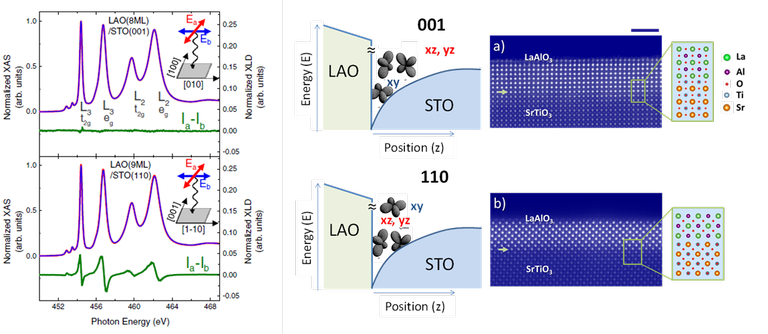By investigating the electronic properties of two-dimensional electron gases (2DEGs) forming at LaAlO3/SrTiO3 oxide interfaces along [001] and [110] orientations, the study shows that the different crystal orientation imposes different orbital symmetries and arrangements to the electronic states quantum-confined at the interface. The study combines the fabrication of atomic-quality oxide thin film samples via a cutting-edge pulsed laser deposition system and expertise of the group at ICMAB, together with the high-sensitivity and accuracy of soft X-ray spectroscopy experiments performed at the BOREAS beamline in collaboration with ALBA staff.
Researchers from the Institute of Materials Science of Barcelona (ICMAB), Universitat Autònoma de Barcelona (UAB), Universidad Complutense de Madrid (UCM), Instituto di Struttura della Materia (Italy), Oak Ridge Laboratory (USA), and ALBA Synchrotron have analysed the different orbital symmetry and electronic structure of the quantum-confined electronic states – so-called two-dimensional(2D) electron gases - at LaAlO3/SrTiO3 oxide film interfaces. Some oxides thin film interfacess have been very recently discovered to exhibit unexpected physical properties such as superconductivity or magnetism, and the engineering and control of those emerging electronic properties is at present a topic of strong scientific interest due to the manifestation of novel fundamental phenomena and properties, as well as their potential for new applications.
According to Gervasi Herranz, from the ICMAB institute and a leading author of the study, this study gives the fundamental basis and paves the way to the control of the symmetry and structure of the electronic properties at the oxide interface. It really opens up the door for new pathways in 2D-electronic engineering in these emerging systems", he concludes.
X-ray absorption spectroscopy experiments at the Ti-L2,3 edges carried out at the BOREAS beamline of the ALBA Synchrotron where key to show the different hierarchy (energy arrangement) and symmetry of the electronic states. According to Manuel Valvidares, scientist responsible of BOREAS beamline, this shows that the ALBA Synchrotron is effective in providing new possibilities to enhance fore-front scientific research performed by national groups and in particular at local laboratories such as the ICMAB.
The study was possible thanks to the combination of, on one side, the expertise and instrumentation for the fabrication of atomic-quality oxide film samples via a avant-garde pulsed laser deposition system at ICMAB institute, and, on the other side, the high-sensitivity and accuracy of soft X-ray spectroscopy experiments performed at the ALBA beamline as well as the complementary skills of BOREAS beamline staff.
Fig: (left) Absorption spectra (and linear Dichroism) of LaAlO3 (8MLs) /SrTiO3 thin film oxide structures with (001) and (110) orientation; (middle) Corresponding energy level of the electronic (quantum-well) states at the interface; (right) transmission electron microscopy images demonstrating the atomic-quality of the fabricated samples.





